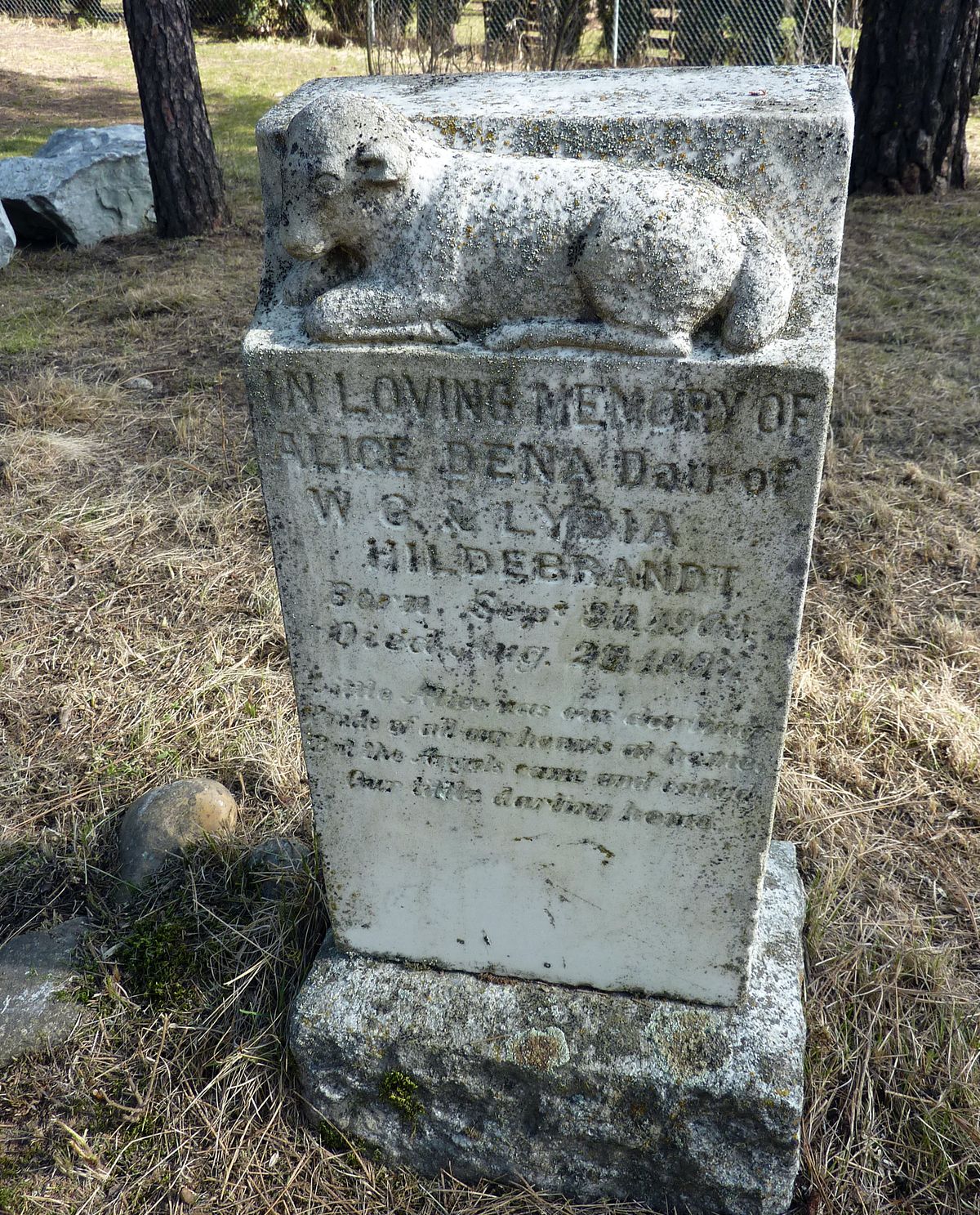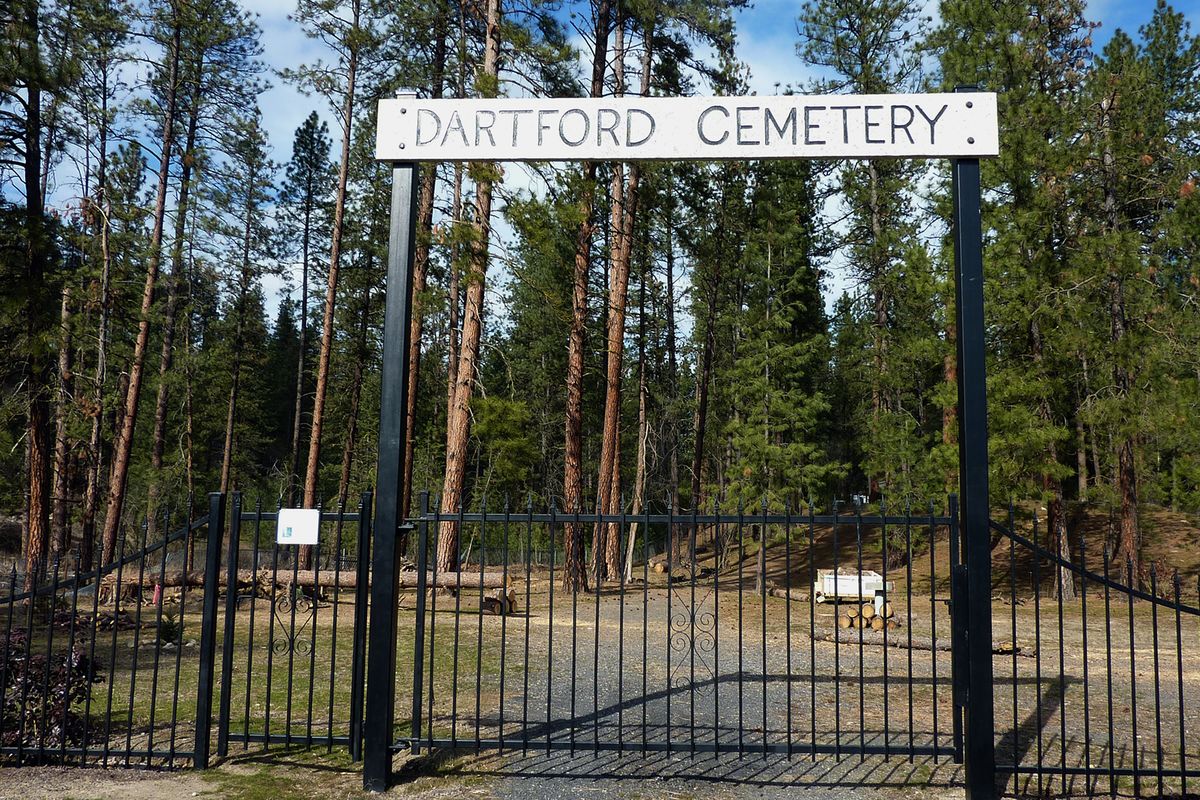Landmarks: Dartford Cemetery reminder of bustling community
Gravestone at Dartford Cemetery.
Not much is left to show that the small community of Dartford ever existed. There’s a portion of an old rock wall on Camp Fire’s Camp Dart-Lo property on the Little Spokane River, the old Ziegler family home, the barn built by original homesteader Herb Dart and a few other remnants here and there.
But if it weren’t for the Dartford Cemetery a mile or so west of Wandermere Golf Course – well, no one might know that a community had ever grown up and been supported there by a flour mill, general store, sawmill, post office, schoolhouse, livery stable, briquette factory and lumberyards into the early half of the 1900s.
Brothers Herb and Lafayette Dart started their mill along the Little Spokane River just north of Spokane in 1883, after which the little town that would carry their name began to blossom. The grist mill closed in 1922 and was torn down in 1943. Other structures gave way for other purposes, mostly residential development, including the Rivilla Neighborhood, where the two-acre, natural-area cemetery still stands. But Dartford itself is gone.
The cemetery came into being in 1896 when Herb Dart donated the land at what is now 610 W. Hazard Road so that pioneer Neeltje Blom Esveldt could be buried there. The Dartford Cemetery Association formed in 1900, with its first board of directors consisting mainly of women. Dues were 25 cents a year, and in the year 1900 a rectangular lot that could hold six graves could be purchased for $6, according to Connie Bunch, a current member of the association board. There are still a few burials there each year.
For many years Pete Esvelt (spelling changed from the original Danish), great-great grandson of the cemetery’s original occupant, served as unofficial caretaker. Recognizing that he was probably the last person living to remember the names of Dartford citizens who were buried there and whose markers were crumbling, he put up metal markers with their names on them so that they wouldn’t be forgotten. When he died in 2009, Connie and Bill Bunch took over care of the cemetery – Connie handling the administrative work and Bill the physical maintenance, each donating several hours a week in this labor of love.
The Bunch home is adjacent to the cemetery. They began their involvement when their only child, 18-year-old Amanda, a senior at Mead High School, died of leukemia. She is buried just beyond the arborvitae and chain-link fence that separates them from the cemetery. They put up a tall headstone with icons from their daughter’s life embedded in it that they can see from their home.
Some 144 people have been laid to rest at Dartford, though Connie Bunch believes there are others buried in unmarked graves in what was known as the paupers’ section of the cemetery. There are officially 700 plots platted, but in reality, because of a steep slope and the fact that many large pine trees are dotted throughout, there is probably just room for an additional 300 burials, she said, adding that the cemetery’s appeal remains its low cost (there is no perpetual care) and rural natural setting, which has attracted people to buy plots there today.
The cemetery is maintained by community effort. When the original gate needed replacement, retired physician Hilmi Mavioglu, whose wife is buried there, donated funds for it. A welding class at Spokane Community College put together the 150-foot wrought iron front fence and a group of Boy Scouts helped put the fence and gate together a few years ago as an Eagle project. The original sign from 1921 was repainted by Connie and volunteers and also put back in place.
Bill Bunch organizes clean-up events at the cemetery, often followed by a barbecue at the Bunch home, and they always appreciate any help they can get. They are still dealing with downed trees from last summer’s fierce windstorms and, of course, the never-ending process of pine needle removal. “It’s always a struggle to keep the graves clear and the grounds at least somewhat in order,” he said.
Over the years they have observed many touching things, such as a man who hand-dug the grave for a loved one. There was also an elderly member of the Hildebrandt family who would come with flowers every Memorial Day with five generations of her family to visit the grave of her sister, who died at age 3.
Connie Bunch has been researching the cemetery’s history and that of the people buried there and has found a wealth of information about the early settlers of the area. She notes that there are many types of headstones and an interesting mix of people laid to rest at Dartford Cemetery – including Robert Bocksch, a Whitworth University chemistry professor, and John P. Esvelt, planner and senior engineer for Spokane’s Expo ’74.
What’s especially interesting, Connie Bunch said, is that the Dart family owns several plots, but there are no Darts buried in the cemetery at Dartford. “As a matter of fact, we have no contact information on even how to reach any of them.”

